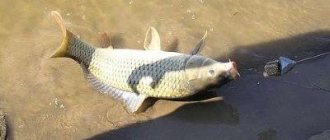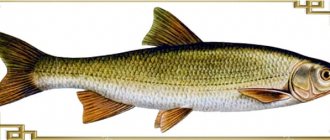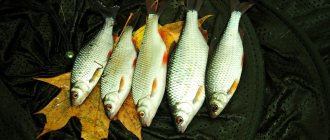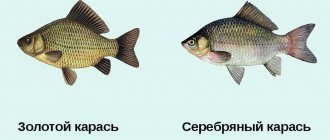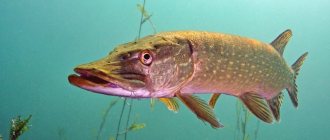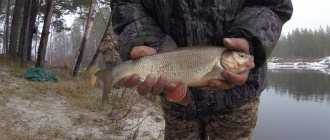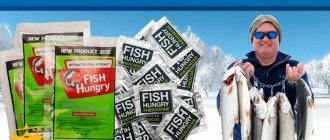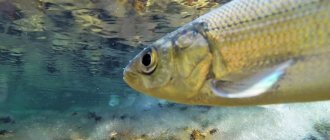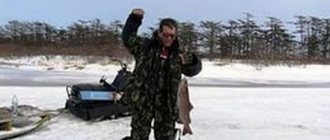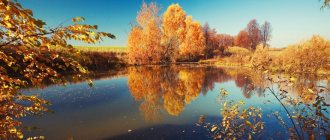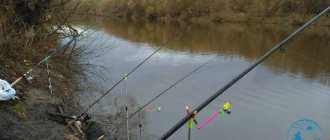Description
Rybets (or Syrt) is a freshwater and semi-freshwater fish of the carp family.
The body of the fish is elongated, but quite wide. Color changes depending on the season and life cycle.
From early summer until late autumn, the body is metallic gray with a blue tint, gradually becoming lighter in color towards the belly. And only the ventral and gill fins have a reddish tint.
But during the spawning period, the fish transforms. The back becomes almost black, and the sides and belly acquire a bright color ranging from orange to purple. Males have characteristic bumps and dots on their backs.
The head is triangular, oblong. The mouth is slanted and retractable.
The main distinguishing feature of the fish is its nose.
It is large, fleshy, takes up most of the head and almost completely hides the mouth.
The dorsal fin is short and high. The tail has a clear v-shape. The pelvic and gill fins are small and pointed.
Most often, individuals are found up to 30 cm in length and weighing up to 500 grams, but under good conditions they can grow up to 50 cm and weigh 2 kg. Maximum life expectancy is 17 years.
Tackle
I admit that when float fishing at depth, many will prefer long Bolognese rods, which allow the use of rigidly fixed floats with two attachment points. However, in the wind, a 6-7-meter “lapdog” turns into a mast. 4-5 meter ones still somehow cope with the wind, but their length is often not enough to use fixed floats.
In this case, I prefer to use match rods with sliding floats. The structure of this tackle allows you to cope with a large fish that unexpectedly takes the bait, and under our deep edge you can expect a large carp or carp. The main fishing line with a thickness of 0.16-0.18 mm is wound onto a spinning reel; the load can vary from 6 to 10 g, depending on the current.
Inertial reels, which many fans of line fishing suggest using, of course, have their advantages - it’s easy to release the line and slow it down. But you can also adapt to a spinning reel, which has its own advantages - fine tuning of the friction brake, the ability to cast away from the boat.
Why to the side? Sometimes the fish takes from the feeder when the nozzle passes across the stream and the leash straightens in an arc. This is a rather complex, but effective fishing technique - casting upstream of the boat so that the equipment can quickly reach the bottom and pass in an arc along the stern plume. Constant recasts are exhausting, but this technique often gives an excellent effect.
Behavior and nutrition
The semi-anadromous and anadromous lifestyle determines the seasonal migrations of the fish. Fish enter the Kuban River from coastal areas in late autumn with still unripe eggs.
It begins moving to other rivers in early spring just before spawning. Upstream, flocks of syrti go all the way to the stormy mountain sources.
Having finished spawning in mid-summer, the fishermen migrate back to their habitats in coastal areas and low-salt estuaries. It feeds there until late autumn.
It eats animal products: insect larvae, plankton, small crustaceans. He does not disdain plant foods.
During the summer feeding period, it likes to graze on the sandy bottom at medium depths. With the onset of autumn cold weather, fishermen (except for Kuban populations) go to the depths, where they look for underwater holes and depressions with a slight current. Here he continues to feed until spring.
Habitats
Although the reservoirs of Central Europe are considered to be the birthplace of syrti, in some countries (Spain, France, Italy) this fish is not found at all today. But in our country, fisherman can be caught in many regions of the southwestern and southern parts of Russia.
A large population of syrti lives in the Gulf of Finland, as well as in Ladoga and Ilmen, Neva and Narva. The small fish is found in the Dnieper and Dniester. The Caspian subspecies is found in the Volga, and the small Black Sea fisherman lives in the Kuban.
Photo 1. In the open space of a small river.
Spawning
The start time of spawning depends on latitude - the further south the body of water, the earlier spawning will begin. The same applies to the age of fish maturation - in warmer latitudes, fish fish become sexually mature at 3 years, in cold latitudes - at 5-7 years.
At the end of autumn or beginning of spring, fishermen leave their feeding grounds and go upstream. Its target is rocky rifts at the headwaters of rivers up to a meter deep. The fish come here in small groups.
The females, standing against the current, slowly spawn eggs, which are attached to the stones and gravel at the bottom. Spawning occurs only during daylight hours. During the spawning period, the female lays eggs 2-3 times.
The egg bed can hold from 30 to 120 thousand eggs. The incubation period is 3-7 days. Already on the 12th day after hatching, the fry begin to feed on their own. A month later, having reached a length of 2-3 cm, the fish begin to slide downstream in small schools.
Diseases and parasites
Like any other fish, the fish is characterized by various viral and parasitic diseases, such as post-diplostomiasis, opisthorchiasis, clonorchiasis, nanophyetosis and ligulosis.
But do not confuse possible signs of infection with mating color during the spawning period, when the fish are greatly transformed, become brighter, and the males are decorated with tubercles and become rough.
It should be remembered that even healthy-looking fish must be carefully processed before being eaten.
Source: blogribaka.ru
| Rybets - one of the most popular fish in the south, incredibly tasty. But even in May, in the Rostov region, not everyone catches it, although in recent years, due to intensive fish farming in many pond farms and fish hatcheries, the fish population has increased significantly. Hunting for small fish differs in many ways from catching widely available fish, and primarily in that it bites best in the pre-winter and winter periods. As soon as the water temperature reaches summer values, it either rolls into the sea or accumulates in the pre-estuarine spaces. Fishing for it begins in the Don closer to August and mainly from the river fairway. They are caught mainly with ring gear, at depths of 5 to 10 m. In the summer heat, fisherman hang on to the riverbed edges , rich in oxygen. Like any Centophagus, the fisherman examines these edges with its lower mouth in search of food. A school of fish grazes on the ledges of the bottom, in places where something edible may be found. Closer to autumn, when the water gets colder and near the coast, schools of fishermen approach them, and guide fishermen who know this feature catch them with lighter float tackle, if 6-10 gram floats can be called such The fisherman is afraid of the boat at depths of less than 3-4 m, there, in the water that has brightened by autumn, he sees from afar the shadow of a boat in sunny weather. therefore, the length of the float often exceeds 10 m. It prefers a bottom that is not silted, but also not too clean, as on sandy beaches. The most promising bottom for fishermen It is considered clayey, with a light sandy coating, with small banks made of shell druses. In southern rivers, such microbanks consist mainly of three types of bivalve mollusks - zebra mussels, toothless and pearl mussels, and gastropods - meadows. All of them, to some extent, also constitute the food of the fish, but only until they are still not very old and their small valves are easily susceptible to pharyngeal teeth. Between the drusen of shells there is always a lot of food, which attracts various bottom fish, including fish. In spring and autumn, at depths of 4-5 m, small fish can be caught using a wire, but even here it is not easy to catch. Any incorrectly constructed equipment scares him. A slightly faster immersion of the bait due to an unsuccessful placement of the sinkers when braking in the current can alert him, and then even his most favorite bait - maggot or crayfish meat - will not tempt him at all. Sometimes you can guess his current mood about food right away, but sometimes you have to waste half a day searching for the right montage. Specialists in fishing for small fish in the wiring very little. This is true fishing art. Despite the vast experience of catching it, you can leave the reservoir with nothing, without understanding what’s the matter, why today the fisherman is especially obstinate... When the water temperature is 1-2°C in December, fishermen in large rivers go to extreme depths, adhering to such sharp edges that it is almost impossible to find them without an echo sounder, or if you do not know all the bottom differences up to a meter. You can stand all day 2-3 m from a school of fish and only one or two fish will separate from the school in half a day, reacting to the best bait. Imagine: this happens during the main fishing period for small fish , from November to the end of March, until it began to rise up the river to its shallow spawning grounds in the tributaries. A “section” with an echo sounder gives approximately the following picture of a deep river channel - from the shore there is a gradual drop of up to 10 m at a distance of up to 30 m from the coastline, then holes are drawn up to 15-17 m, and the diameter of a hole with a depth of 17 m is only 3-4 m It is in it that fish will constantly accumulate, going to the hole along the river from below. The question involuntarily arises: “Why doesn’t she take it on the approaches to the pit?” Yes, because the fisher simply does not feed until it reaches its feeding station, to which it approaches at half-water, without reacting to anything. Only after finally reaching a depth of 16-17 m (or at least 10 m on other channels) with a suitable bottom, the school will stop and begin feeding. In the coldest time - in January - he is not tempted even by the maggot he so loves, and then the only bait that he definitely will not be afraid of will be bloodworms. And if you find a flock, both a “ring” and a feeder work well. But then the bite subsides, and then stops altogether. Something alarms the school, a search begins for the reasons why this happened, experiments in restructuring the gear begin. And one of them is determining the optimal leash length, which can sometimes be simply incredible. One day I watched as a fisherman standing nearby extended the leash to... 5 m! And if before this he had not had any bite, then the fish suddenly began to take the bait carried far away by the stream, as in the spring-autumn case when the float was released up to 15 m from the boat. But a boat standing over a 17-meter hole should not frighten a school of fish. So it's fish The very appearance of the feeder is alarming. At what distance does it no longer scare the flock? You have to use several hooks located every meter, and this helps to finally determine the length of the leader at a given time of feeding of the fish. Sometimes it is useful to replace the bait, replace the bloodworm with crayfish meat or shrimp, which are often more effective than local crayfish due to the specific sea odor. So, we accurately, down to the meter, calculated the location of the school of fish, determined the length of the leash by tricks to determine the distance at which it feeds at a given time, and finally found a suitable bait, but this does not mean that the fishing will be successful. This is the time to remember one old method of catching small fish, which was known to us twenty years ago, when the winter was quite warm and there was no ice on the river. At that time, ring tackle was just being mastered on the Don. One of my fishermen friends then used a rig with three short hard leads on the main line, the final one was a small sinker with variable weight, barely reaching the bottom in the current. The sinker was placed as light as possible, to give delicacy to the entire tackle, and only with this condition did the fisherman take the bait. Simple small “ovinka” jigs played the role of a fry or an insect holding a bloodworm in its mouth. The only insect suitable for this role was the smooth bug, which has a similar shape - it can sometimes be seen in the stomachs of fish fish . The druses of shells also contain bloodworms, small caddisflies and amphipods, which can also be imitated by jigs. They were placed on short leashes about 5 cm long - 20 cm from the bottom sinker and above with a gap of 20 cm. And the fisherman pecked at such tackle. Remembering that fishing trip, we also decided to use equipment with jigs , and it worked better than the simple hook rig. From the magazine FISHER 5-11-2011, 15:11
|
Source: www.ryblib.ru
What gear is best for fishing on the bottom [gear for catching rams - feeder and float]
To get cheese and taste its delicious meat, the fisherman will have to make a lot of effort. Fishing for fish is carried out in different ways. The best option is selected taking into account the time of year.
- In winter, you need to look for fish in deep holes. Fishing is done with ordinary float rods with jigs. Most often, a natural bait in the form of a bloodworm or a worm is placed on the hook.
- In spring, success largely depends on the right choice of location. When the pre-spawning run begins, bait for fish will help to delay the school for a while. During this period, it is best to fish with a float and retrieve it.
- In summer, the fish hold on to a good current. A long-range feeder helps you find parking spots.
Photo 2. Fishing on a feeder. - During the fall, fish can move from shallow areas to greater depths. Therefore, it is promising to fish the entrances and exits of pits using bottom or float gear.
When do we expect the ram to move this year{q} I have already collected everything, as they say, I am sitting at the door. Eqilibrium, March 2 Virtuos, March 2 Eqilibrium, March 3 We need to plan a ramming trip for next Saturday. Yesterday I went for a ride and made some inquiries. Taran is in flocks, in the winter version, they are caught, but not like that, the move has not yet begun. She spends most of her time at sea, but prefers to stay in coastal zones and places where rivers flow into rivers.
Considering that this type of roach is not a sea fish, the ram does not tolerate too salty water, so you should not look for it in areas with a salt content of more than 7 ppm. The favorite places of this small fish are the mouths of rivers flowing into the seas, canals, bays and estuaries. She does not spawn in sea waters, but goes into rivers, canals and bays. Here the water warms up better, as well as more vegetation, which will both protect and feed the offspring.
During the spawning period, in order to preserve the population, ram fishing, even amateur fishing, is prohibited by law, so there is no need to talk about spring hunting for this fish yet. Conscientious fishermen begin to catch ram only at the beginning of summer, when, hungry, it returns to the sea. The best places for hunting this fish in early summer are considered to be coastal thickets of reeds and water lilies, island channels, overgrown canals and estuaries.
In summer, the fish is very active and unpretentious in terms of feeding. It can be caught with almost any bait, from various cereals to an ordinary earthworm. But it is still preferable to use maggots, bloodworms, or combinations thereof. Fishermen use a regular float rod and various bottom devices to catch rams. The main food source of the toothed predator at this time is small sabrefish and roach, so fishing with live bait in the fall is very popular.
For example, Don fishermen of the Volgograd region actively practice fishing for pike and pike perch on a feeder in the autumn. Either small fish or live bait is used as bait. But, as throughout the year, the most active predator is pike perch. Autumn fishing for pike perch on the Don lasts until the freeze-up. Silicone and foam baits give good catches at this time. Among the peaceful fish in the autumn, crucian carp, buffalo and bream actively feed.
Some fishermen use the smell of chocolate to feed bream. Natural baits are more commonly used - worms, maggots, bloodworms.
Don feeder fishing gives the best results for bream in the autumn. Bolognese and match fishing rods are more often used for catching sabrefish and roach. The most impressive results in terms of catches are shown by fishing on the Don in November. Everything is written in a very interesting and informative way, I would like to get there, but I think there is still more to come. Many thanks to the author for his efforts. You can use these tags: Notify me of follow-up comments via email. Home Sitemap Contacts.
Fishing on the Don Fishing. Tips, fishing spots, recipes for cooking fish. Uncategorized Pike Fish Fishing methods Fishing features Fishing time Rivers Bait Accessories. Home Features of fishing Fishing on the Don. Fishing on the Don video.
- How to store your fish finder battery
- Strike pro light spin
- Fly fishing rods models
- Catch in contact program without registration
Don, crucian carp, Bream, fishing, Pike. You might like: Detained poachers told the secret of their success for a good bite. Fishing inspectors were surprised by the absence of prohibited equipment. In stores, such a set is much more expensive. If you want your fishing to be successful, be sure to go to the Don River. It cannot be any other way, you just need to get to know some of the features of this river better.
After all, the Don is the Don and it has its own specific fishing and requires different, special gear. I talked a lot with Don fishermen, watched a lot of films on this topic - the locals have such gear that you think - wow, how can you fish with them {q} It turns out that it is possible and quite effective. I have a question about the designs of bottom gear for fishing on the Don in our middle reaches of the river.
Here the locals use feeders weighing grams: I met one - he throws a mallet - well, this is almost a clinical case. But the most interesting thing is the thickness of the fishing lines used by locals: So, who uses what thickness of fishing line or wattle for donkeys on the Don{q} And what do all these parameters depend on{q}
There are Don fishermen here{q} Don gear really amazes with its roughness and reliability.
For successful fishing in this area, it is more advisable to fish from the shore; the main thing is to choose the right gear and equipment, taking into account the expected weight and type of fish. Fishing methods Fishing gear Accessories for fishing Fishing spots Water transport Fishing kitchen Effective BAIT for fishing is going to be banned from You shouldn’t pull too hard, as the worm can break in half. There is a little trick - if you pull the worm a little from its shelter and immediately release it, the worm relaxes, after which you can pull it out without any problems.
You can store earthworms in a wooden box filled with soil, and if necessary, take it with you fishing, do not forget to water the box from time to time. You need to arrange the donks like this - one at the very bottom of the pit, the other two on the sides, on the slopes of the pit. Securely secure them to the holders, and adjust the reel brakes to loosen the line in case of a sharp bite. Don’t forget that catching catfish is an extremely slow, meditative process, so you will have to wait, depending on the correct location, up to 3 days, so stock up on food, warm clothes, a supply of firewood and, most importantly, patience.
FisherGoMan - self-hooking fishing rod! Every experienced fisherman knows that when fishing it is very important not to miss the moment of the bite! One of the advantages of this bait is the possibility of catching both sterlet and pike. To more effectively imitate blende, it is necessary to use the caviar smell and the red color of the silicone itself. It is worth trying various soft products in the form of bait. However, as soon as dusk falls, it appears in shallow water, swimming in the coastal vegetation.
Tackle for catching small fish: what is used to catch it in the fall
On the Don there is a ban on the use of such equipment as a ring. If you are a beginner and read somewhere that “ringing” is the best way of fishing, do not rush to do it. The fines are large, and it is more profitable to be a law-abiding fisherman, especially since there is legal fishing gear that is no less catchy - fishing eggs. The principle of operation is similar, but it is considered to be more humane. It’s strange, but true – you can catch small fish on the Don with eggs, but not with a ring.
In the spring, the highest activity of the fishermen, called rybchik on the Don, coincides with the fishing ban, which is why fishermen look forward to autumn with such impatience. But at this time the fishery inspection makes sure that the fishing gear for fishing is not poached; on the Don in the fall there are restrictions related to the proximity of hydraulic structures, this must also be taken into account when choosing a fishing spot.
One of the promising places in the lower reaches of the Don is considered to be the non-navigable channel of the delta. Landmark - the width of the river here is less than in other areas. If you are in those places, local fishermen will definitely offer a trip to Rogozhkino. There are always a lot of people here. Experienced comrades go fishing in the evening in order to have time to take a good place. It will be difficult to do this in the morning.
Fish in the fall is caught on:
- Fishing eggs (lead cheeks);
- Feeder;
- Into the wiring.
The gear, which is more often called “fishing eggs”, is known in some places as lead cheeks. It is used on the Don for catching small fish and bream.
In autumn, as the water gets colder, the fisherman comes closer to the shore, which makes it possible to use float gear. But this only applies to early autumn. Later, at real autumn temperatures, the fisher will move to a depth that is uncomfortable for fishing from the shore, and then the Bolognese tackle will be available only to those who fish from a boat. The exception is fishing from the embankment. Here, those who like to go fishing with a float stay until the very frosts.
When fishing from a boat, bites, as a rule, occur at a distance of 10 meters from the craft, since clear water forces the fish to stay away from an object that poses a danger. The shadow from the boat is especially annoying when fishing in clear sunny weather. On such days, the float should be released further away. The bite of the autumn fish is powerful, but you need to hook it carefully, since its lip is weak and can easily be torn off.
Since the fish is cautious, when fishing on a feeder, a meter-long leash is used, but there are exceptions when the bite begins only after the leash is shortened to 30 cm. To reduce the number of trips, it is recommended to use a feeder gum.
Fishing on the Don
Fishing on the Don is almost always productive, you just need to know some of the features of this river, which will be discussed. In general, the Don is rich in fish, including both permanently inhabiting and spawning herring, ram and other species that only fuel interest in local fishing.
Fishing spots on the Don.
As with any body of water, there are areas on the Don that should be especially highlighted. First of all, I would like to note the Sholokhovsky district - it is in the upper part of the river. Fish activity here remains all year round, so many anglers prefer to fish here during the so-called quiet periods. They catch both peaceful fish and predators with equal success. Large bream are being actively caught; fly fishing enthusiasts come to the numerous riffles of the upper river to try their luck in catching chub. There are a lot of pike perch, which are mainly caught on floating wobblers or foam baits.
There is a huge amount of rudd and small silver bream on the upper Don, so if you are going after large fish, you will have to take a more detailed approach to choosing bait. Therefore, it is recommended to use something larger, such as boilies, pearl barley and corn.
If we talk about the middle part of the river, then the Tsimlyanskoye Reservoir will certainly be in first place. It is especially popular among lovers of carp fishing, which is active almost the entire period of open water. Millet with cake has proven itself to be the best bait for it. Silver bream, roach and bream are also well caught. If we talk about predatory fish, then this is the same pike perch, a lot of pike, and there is catfish, and quite large ones, especially at night.
Fishing in the lower reaches of the Don is no less popular. First of all, this is explained by the proximity to the city, the presence of a large number of suitable places for fishing, as well as the possibility of catching fish such as eel and goby. Fly fishermen purposefully come here for asp, ide and saberfish.
Fishing time on the Don
In autumn, with the gradual cooling, the most popular fishing on the Don becomes large pike. They catch it with equal success using both artificial bait and live bait. Pike perch also remains active and is caught until the river is covered with ice. Among the peaceful fish, bream, crucian carp and buffalo go well, in the upper part of the river roach bites well, and in the lower reaches of the river there is good fish. As for carp and carp, they are mainly caught in early autumn; as soon as it gets a little colder, their bite weakens significantly. The fish most willingly go for natural baits, such as worms, maggots and large bloodworms.
The first ice on the Don is an excellent time for catching roach and bream. In areas with strong currents, where there are deep holes, schools of gobies often stay, and crucian carp are active in the upper reaches, quickly preparing to spend the winter. They fish on the Don throughout the winter; the so-called low winter period practically never happens here. The pike perch still continues to hunt, which is very attracted to the balancer; in rare cases, the bream remains indifferent to the play of a large jig.
Fishing on the last ice is also very productive. The first crucian carp begins to be caught, and the asp becomes active. With the onset of the flood, when the water level is low, pike, pike-perch and perch are successfully caught. Roach and large crucian carp are also found among the trophies.
From approximately the second half of April to June, fishing restrictions begin to apply - fishing is only allowed from the shore. However, this does not hinder fishermen at all; this period is notable for the fact that asp are good on live bait, and trophy bream are caught well on the feeder.
Fishing on the Trasna Reservoir
morefishing.ru
Groundbait and bait for small fish in autumn on the Don
The taste preferences of fishermen change not only depending on the water temperature in the fall, but also on the fishing location. When within the city limits of Rostov-on-Don it responds only to shrimp, near Novocherkassk it is quite successfully caught using maggots. So, baits for fisherman:
- Maggot;
- Cancer cervix;
- Shrimp;
- Worm;
- “Sandwich” maggot and bloodworms;
- Scented foam balls.
The best bait for catching autumn Don fish is considered to be raw crayfish meat. The neck is cleared of the shell and placed in a container of water, which is placed in the refrigerator.
In order for the prepared necks to acquire the desired consistency, they are kept in a jar of salted cold water, so they will become harder and will stick well to the hook. Alternatively, use a rubber band for pellets to secure the bait.
Regardless of the time of year, maggots work great. The larvae are planted in a bunch. The shrimp is covered with maggot so that it holds better; it is included in the sandwich. The sandwich uses live mosquito larvae and artificial bloodworms. Sometimes artificial ones perform better than natural ones. You have to try everything.
To plant crayfish, you need to get it; it’s much easier to buy shrimp. Increasingly, it is replacing the traditional nozzle. There is no need to cook the shrimp; they are already completely ready to be hooked. Before fishing, it is advisable to defrost them in advance, drain the released water and hold it for a while at room temperature so that the meat dries out a little.
Ready-made feeder baits from some manufacturers include mixtures designed specifically for catching small fish, for example, Mironov. The degree of moisture depends on the strength of the current. As a rule, in the second half of autumn, the water level in the Don drops, the current becomes stronger, and the bait is made more viscous.
What shrimp to use for fishing
Shrimp can be used frozen, boiled or fresh. It is better, of course, when a fresh product is used. Although near the shore the fish bite well on boiled crustaceans.
Experienced people say that it’s good to catch shrimp yourself, and then put them on. Although in our areas it is impossible to do this, so products purchased in the store are used.
It should be said that there are several secrets that are worth paying attention to:
- For a better catch, the bait needs to be boiled and then cleaned. Then the meat is left, it will be used for bait, and the shell is twisted in a blender and mixed with the broth in which the crustaceans were boiled. The finished gruel is added to the bait.
- When going to fish for carp, the mollusks are sent into the water. Next, juice from canned corn is poured there. A soaked bait will attract fish better.
- In order for the delicacy to hold up well, before placing the shrimp on the hook, it should be dried immediately after cooking (this can be done in the sun). Not a single fish will swim past the aroma of the crustacean.
Some fishermen are upset that shellfish are disappearing. However, there is no need to be sad in advance, because such a product should be used when going to hunt for catfish, which will happily eat it all. Some fishermen specifically look for damaged bags of shrimp in supermarkets.
It is interesting that the more unpleasant the smell of the stinking delicacy, the more active the catfish will behave and swim towards such an aroma. There are fishermen who deliberately place such crustaceans in the sun so that they finally “arrive.” Spoiled shrimp should be stored in the freezer.
Features of catching Don fish
By mid-October you can already seriously prepare your gear. The rumor that the fisherman has “gone” spreads quickly among fishermen. In autumn, migration to the lower reaches begins, but the migration of this fish takes place in winter, when the river is frozen. The January and February Don fish are the largest. It is caught with ordinary winter gear, using maggots, bloodworms or frozen crayfish meat as bait.
Since this is a schooling fish, when biting small individuals, large specimens are very rarely caught. The big one may be nearby. It happens that one person comes across only small things, while the other catches only good fish. You need to cast downstream from the accumulation of small fish, since the more cautious large fish are content with picking up food after the young fish. The fisherman always stays on the stream, you need to look for him there.
The versatility of the tackle and bait does not exclude the fact that catching the desired fish will not bring in the fall bycatch bream, silver bream or large bleak, which is called sybil on the Don. That's what fishing is for, to give us fishermen surprises. If you want to get inspired before your trip to the river, watch an interesting video from Rogozhkino.
Source: SamRybak.ru
Fishing for small fish on the Don in autumn
How to choose the right place to catch fish
One of the hardest things about fly fishing is finding the right spot. It is practically impossible to guess its location, just come and stand at any point. A promising area for catching this fish is where the riffle ends and the depth begins. Where return flows form, they are clearly visible due to the resulting foam. There must be a current, because it is useless to catch fish in still water. The exception would be if in the coldest time of the year it is completely lethargic.
Together with our fishing friends, we went to the Sheshupe River, where we fished for small fish in the fall. Let's try to catch it using artificial baits, and our partners using live bloodworms and maggots.
